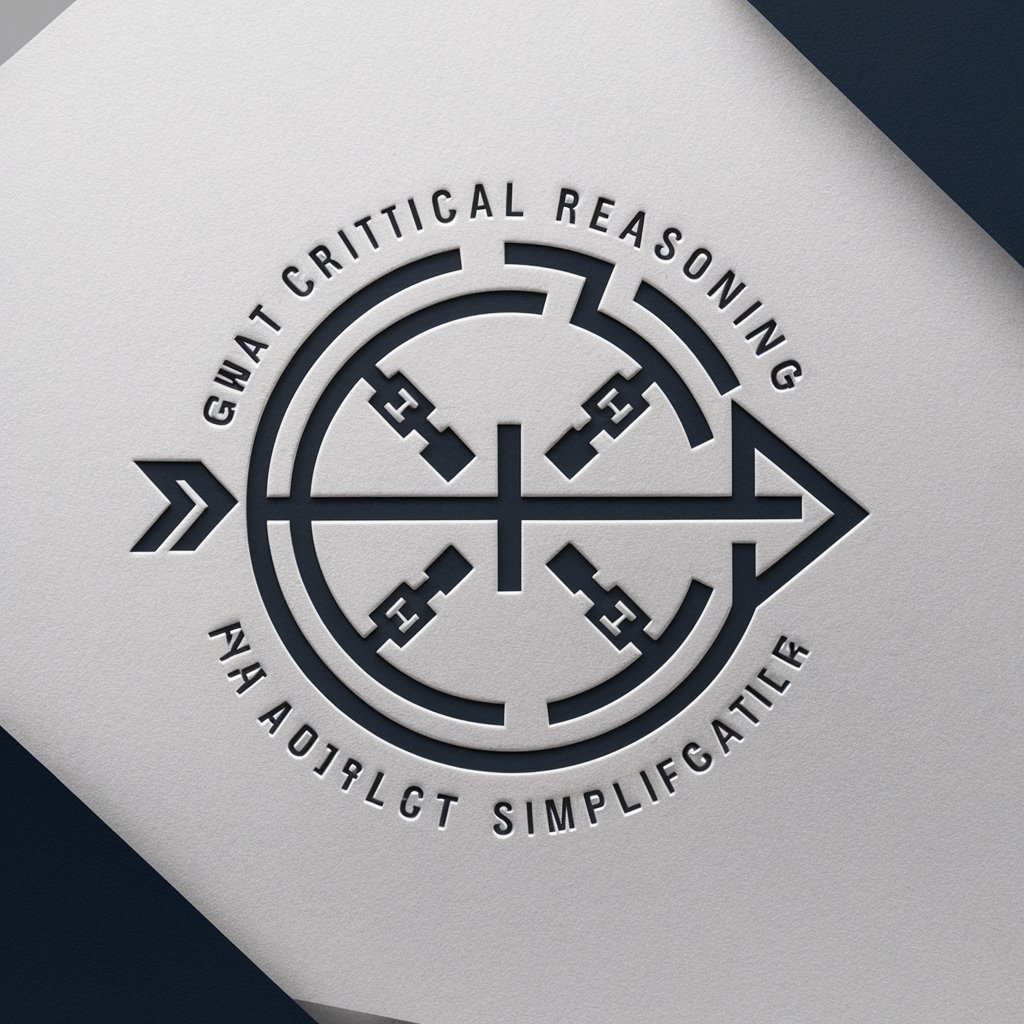Dustin's GMAT CR: Chain (Argument Evaluation) - GMAT Argument Analysis

歡迎使用 GMAT 批判推理分析助手。
AI-powered Argument Evaluation for GMAT
Analyze the logical structure of the following argument:
Identify the hidden assumptions in this argument:
Evaluate the causal relationship in this statement:
Construct a logical chain for the given premises and conclusion:
Get Embed Code
Introduction to Dustin's GMAT CR: Chain (Argument Evaluation)
Dustin's GMAT CR: Chain (Argument Evaluation) is a specialized tool designed to assist users in analyzing and evaluating arguments in the context of the GMAT (Graduate Management Admission Test), particularly the Critical Reasoning (CR) section. This tool focuses on identifying the logical chain between various elements of an argument, from premises to conclusion, and requires users to specify starting and ending points for analysis. It employs a unique notation system involving symbols like '->' for causal relationships, '+' for parallel relationships, and parentheses '()' for hidden assumptions. The primary aim is to help users uncover underlying assumptions and evaluate the strength of the argument's logic, thereby enhancing their critical thinking and analytical skills. For example, in analyzing an argument that claims a decrease in unemployment will lead to higher consumer spending, the tool would help illustrate the logical steps and hidden assumptions necessary for this conclusion to hold true. Powered by ChatGPT-4o。

Main Functions of Dustin's GMAT CR: Chain (Argument Evaluation)
Logical Chain Analysis
Example
Identifying the logical steps and hidden assumptions between an increase in minimum wage and a reduction in poverty.
Scenario
A user presents an argument that suggests raising the minimum wage will lead to a decrease in poverty levels. The tool would help map out the logical progression from increased wages to reduced poverty, highlighting any assumptions, such as the belief that higher wages directly increase disposable income and subsequently reduce poverty.
Critical Evaluation of Arguments
Example
Evaluating the strength of an argument that links environmental policies to economic growth.
Scenario
When faced with an argument that suggests implementing strict environmental policies will spur economic growth, the tool assists users in critically analyzing this claim by breaking down the argument into its logical components and identifying any weak links or unsupported assumptions.
Assumption Identification
Example
Uncovering hidden assumptions in an argument that connects reduced screen time with improved mental health.
Scenario
In an argument claiming that reducing screen time will improve mental health, this tool helps users identify hidden assumptions, such as the belief that screen time is a direct cause of poor mental health and that reducing it will therefore lead to improvements.
Ideal Users of Dustin's GMAT CR: Chain (Argument Evaluation)
GMAT Test Preparers
Individuals preparing for the GMAT, especially those looking to improve their score in the Critical Reasoning section, will find this tool invaluable for practicing argument evaluation and strengthening their analytical reasoning skills.
Critical Thinking Enthusiasts
People interested in enhancing their critical thinking and logical reasoning abilities, regardless of whether they are preparing for the GMAT, will benefit from learning how to dissect and evaluate arguments systematically.
Educators and Tutors
Educators and tutors specializing in GMAT preparation or critical thinking skills can use this tool as a teaching aid to help students understand the structure of arguments and how to critically evaluate them.

How to Use Dustin's GMAT CR: Chain (Argument Evaluation)
1
Navigate to yeschat.ai for a complimentary trial, no sign-up or ChatGPT Plus required.
2
Select the Dustin's GMAT CR: Chain (Argument Evaluation) tool from the available options.
3
Input your Critical Reasoning passage and specify the starting and ending points of the argument you wish to evaluate.
4
Review the generated logical chain that connects your specified points, including any identified hidden assumptions.
5
Utilize the analysis to understand the argument's structure and to practice or prepare for GMAT CR questions.
Try other advanced and practical GPTs
RA Studio 5000 Expert
Empowering Automation with AI Expertise

CinemAI Studio
Elevate Your Content with AI

PixSarcasm Studio
Bring photos to life with AI-powered Pixar magic.

EarthGPT - Maps, Satellite Images, Geography
Explore the world with AI-powered maps and satellite imagery.

Satellite
Transforming Pixels into Insights

Satellite Laser Communication
Empowering space with AI-driven laser communications.

Privacy Buddy
AI-Powered Privacy Compliance Expert

Privacy Pro
AI-driven Privacy Law Mastery

Privacy Guardian
Empowering secure, private conversations with AI.

Privacy Pro
Empowering Privacy Through AI

Powerful Privacy Professor
Empowering Your Privacy with AI

Suave
Elevate your chats with AI-powered charisma.

FAQs on Dustin's GMAT CR: Chain (Argument Evaluation)
What is a logical chain in the context of argument evaluation?
A logical chain represents the sequence of reasoning or causal relationships that connect the premises of an argument to its conclusion, including any hidden assumptions that are not explicitly stated but necessary for the argument's validity.
Can this tool help with arguments outside of GMAT preparation?
Yes, while designed for GMAT CR preparation, the tool's analysis of logical chains and hidden assumptions is beneficial for evaluating arguments in various contexts, including academic research, legal reasoning, and everyday decision-making.
How does identifying hidden assumptions improve argument evaluation skills?
Identifying hidden assumptions helps to critically assess the strength and validity of an argument by uncovering unstated premises that must be true for the conclusion to hold. This skill is crucial for both creating and debunking arguments effectively.
Is there a limit to the length or complexity of the passage I can analyze?
While there's no strict limit, passages that are concise and directly relevant to the argument's main points are more effectively analyzed. Extremely lengthy or complex passages may require simplification or segmentation for best results.
Can this tool generate logical chains for any type of argument?
The tool is optimized for arguments typically found in GMAT CR questions, which involve causal relationships, comparisons, or evaluations. However, it can also be applied to a wide range of argument types with clear premises and conclusions.
